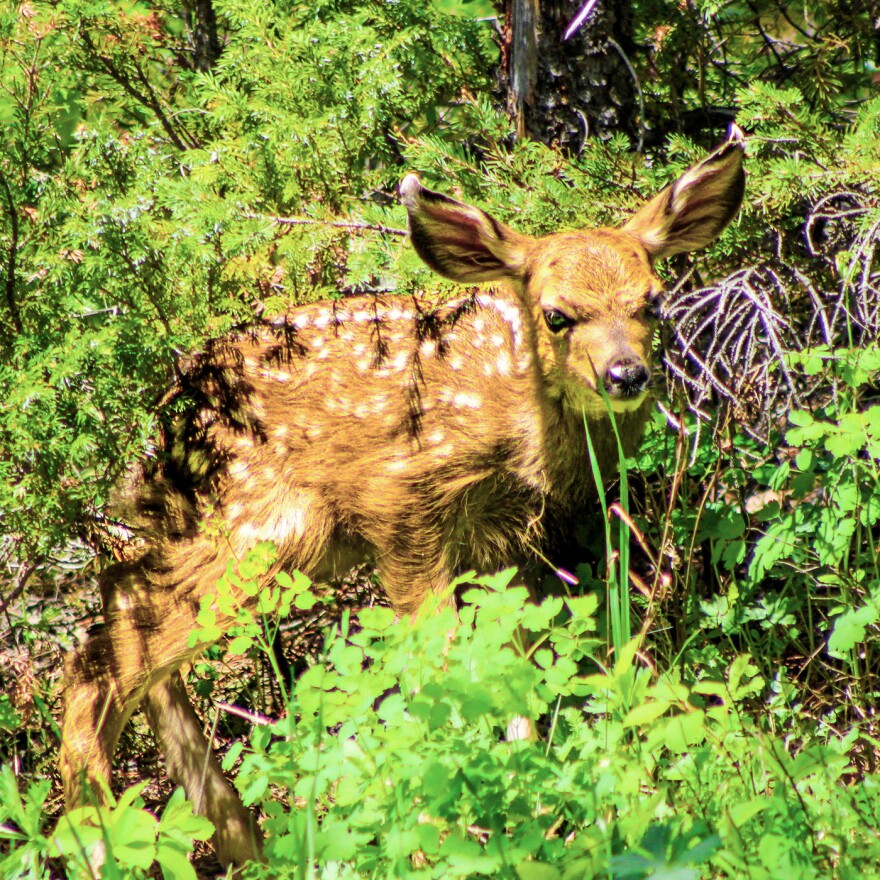A Spotted Coat of Concealment
By Mariella Bodemeier Loayza Careaga
It’s time for Field Notes, brought to you by the Montana Natural History Center.
Summer brings more than blue skies and hot days to Montana. It’s during this time of the year that white-tailed deer fawns are born. Last summer, I was fortunate enough to see a few fawns in my backyard. Sometimes they seemed like well-behaved kids following their mom as she browsed and rested under the trees. Other times, they leaped and chased one another—what I came to consider a deer version of our tag game.
Fawns’ playful behavior can be quite amusing to watch, but it was their coats—specifically, their scattered white spots—that caught my attention the first time I saw them.
White-tailed deer are primarily prey animals, and Montana is home to many of their predators, including bears, coyotes, and mountain lions. To reduce the odds of being detected by a predator, white-tailed deer camouflage—that is, they use morphological adaptations that were selected over millions of years of evolution to blend in with their surroundings.
The fawn’s reddish-brown coat coloration helps match its appearance to the forest floor, especially one covered with dry, brownish leaves. But how can white spots be of any help to these animals when it comes to concealing their presence from a hungry predator?
It turns out that patterns, including spots, help break up an animal’s appearance and body outline. This camouflage tactic, known as disruptive coloration, interferes with an animal’s visual processing by impairing its ability to perceive different features (such as shapes, color, size, and location) as belonging to the same object.
In the case of a fawn, spots touching its body outline can make it difficult for a predator to tell where the fawn’s body ends and its surroundings begin. Spots placed away from the fawn’s body margins, on the other hand, create false edges that likely make the predator question whether there is any prey there at all.
The speckled coat can also help a fawn blend with the sun-dappled forest floor, concealing its presence even further.
Although a fawn’s coat pattern seems to play a significant role in its ability to avoid predators, researchers have recently started studying how much of this trait is linked to genetics, a concept known as heritability. In genetics, heritability is a way to measure how much the differences in a population’s DNA can explain the differences in the traits we see in that population. Moreover, traits that are highly heritable are thought to directly influence a population’s survival. So, if the spotted patterns of young deer are highly heritable, then fawns should respond to selective pressures, such as predation and changes in the landscape, by displaying patterns that best suit their immediate surroundings, thus increasing their chances of survival.
Researchers from Mississippi State University tested this idea and found that the camouflage patterns of fawns are moderately to highly heritable. This means that selective pressures, such as predation, can force changes in these patterns within a fawn population. As a result, the fawns most adapted to blend into their environment become harder to catch, while those that are less adapted become easier targets.
What’s more, in two of the three fawns’ populations analyzed in the study, the researchers were able to determine a fawn’s place of origin just by looking at their camouflage patterns, reinforcing the idea that camouflage is closely linked to an animal’s environment, and thus it varies from one location to another.
While the jolly fawns visiting my backyard have started to lose their spots, I’m glad to know that these scattered little markings helped them remain hidden in plain sight for a while. Hopefully, I will see them again next summer as fully grown white-tailed deer.
This is Mariella Bodemeier Loayza Careaga for Field Notes, brought to you by the Montana Natural History Center, providing natural history education for schools and the public throughout Montana. To find out about upcoming events and programs at the Center, call 406.327.0405, or visit our website at MontanaNaturalist.org.





